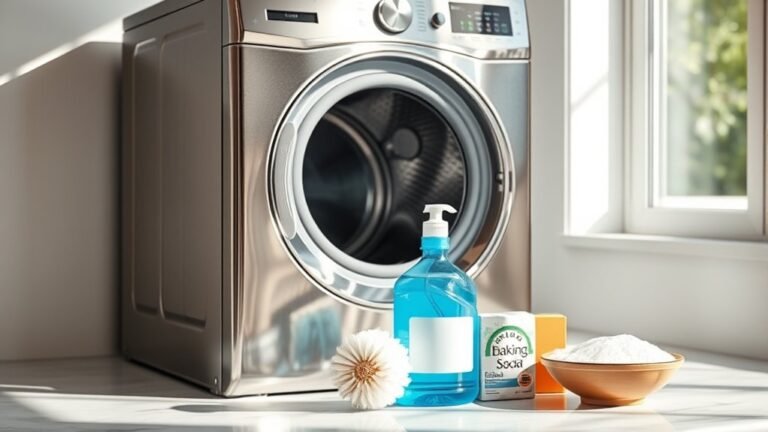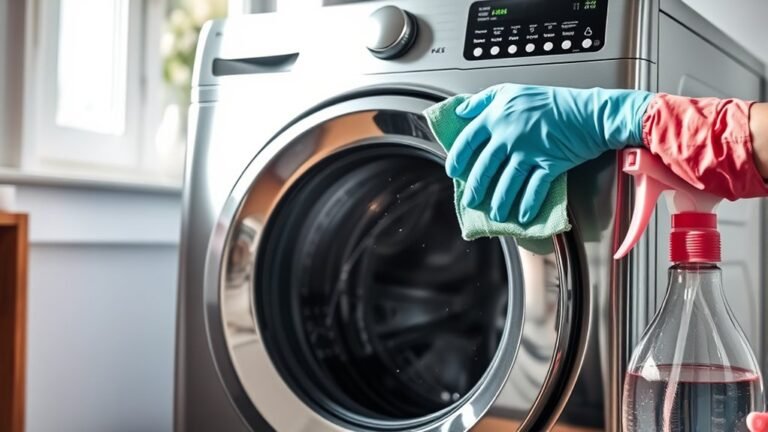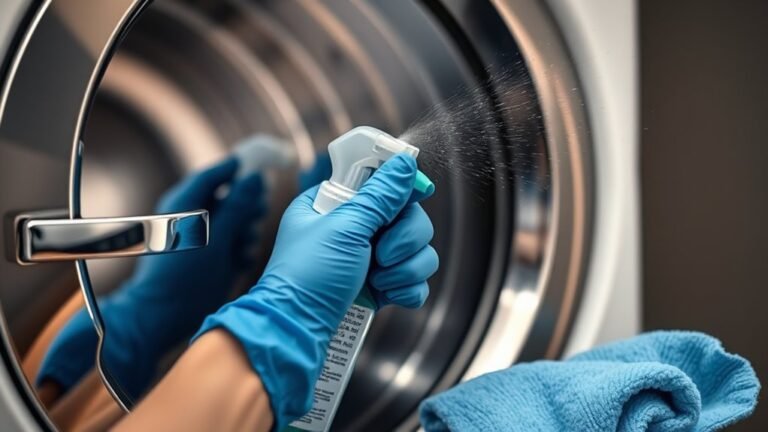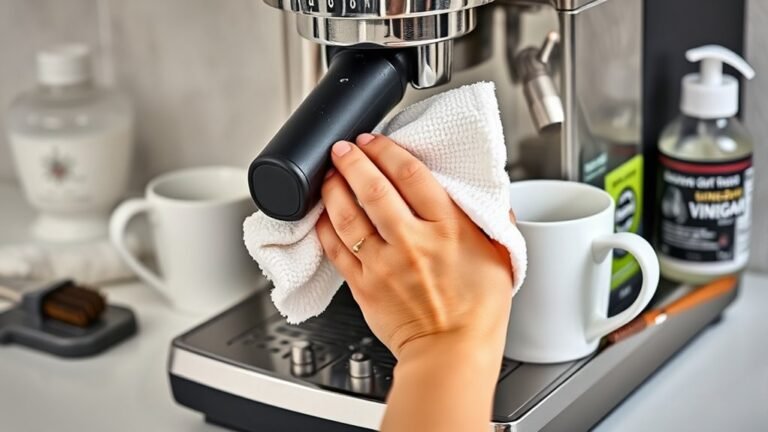Cleaning and Maintaining Your Coffee Maker
You should clean your coffee maker whenever the brew tastes weak or off, or if you notice residue or mineral buildup inside. Use descaling solutions or a vinegar mix to run through the machine, then rinse thoroughly. Regularly wash removable parts like the carafe and filter basket, wiping down the exterior daily. Keeping up with these steps will guarantee your coffee tastes fresh and your machine runs efficiently. There’s more to learn about keeping your coffee maker in top shape.
Identifying When Your Coffee Maker Needs Cleaning
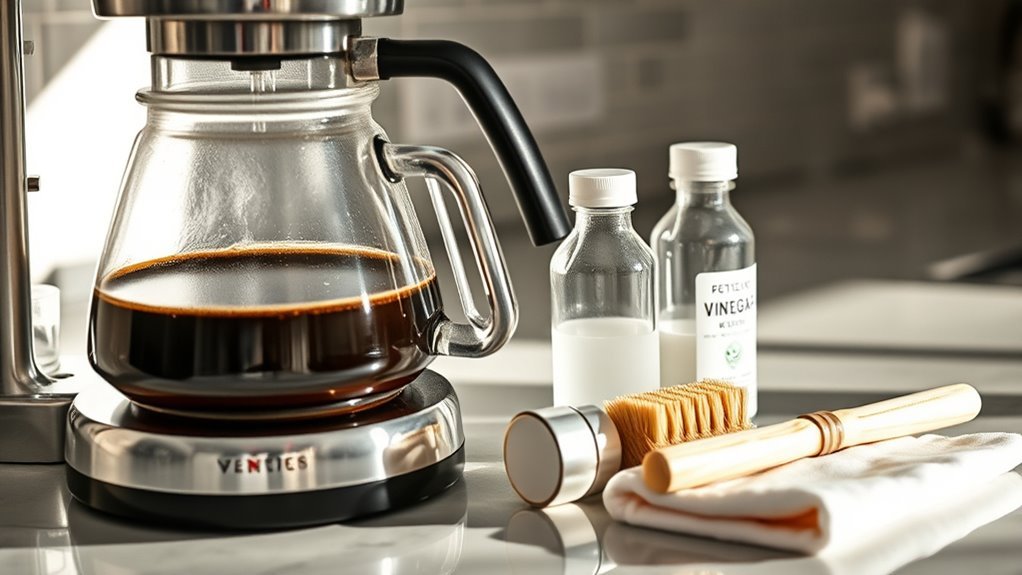
How do you know when your coffee maker needs cleaning? You’ll notice your brew tastes off or weaker than usual—that’s a clear sign. Coffee residue accumulates over time, clogging filters and altering flavor. If you spot any discoloration or sticky film inside the machine, it’s time to act. Mineral buildup from hard water also reduces efficiency, causing slower brewing and strange noises. Don’t wait until these issues control your morning routine. Staying alert to these signs lets you maintain your freedom to enjoy fresh, flavorful coffee whenever you want. By recognizing when your coffee maker needs cleaning, you take control, ensuring every cup fuels your day without compromise. Keep your equipment in top shape—it’s your ticket to daily coffee freedom.
Essential Supplies for Coffee Maker Maintenance
Recognizing when your coffee maker needs cleaning is just the first step; having the right supplies on hand makes the process straightforward and effective. To keep your machine running smoothly and your coffee tasting fresh, you’ll want to gather essential cleaning solutions designed specifically for coffee makers. These solutions break down mineral buildup and remove oils that regular water can’t tackle. Alongside these, maintenance tools like soft brushes, microfiber cloths, and measuring spoons help you reach tight spots and apply solutions accurately. Avoid harsh chemicals that can damage your machine or leave residues. With these supplies ready, you gain the freedom to maintain your coffee maker confidently, ensuring each cup is as satisfying as the first.
Step-by-Step Guide to Descaling Your Coffee Machine
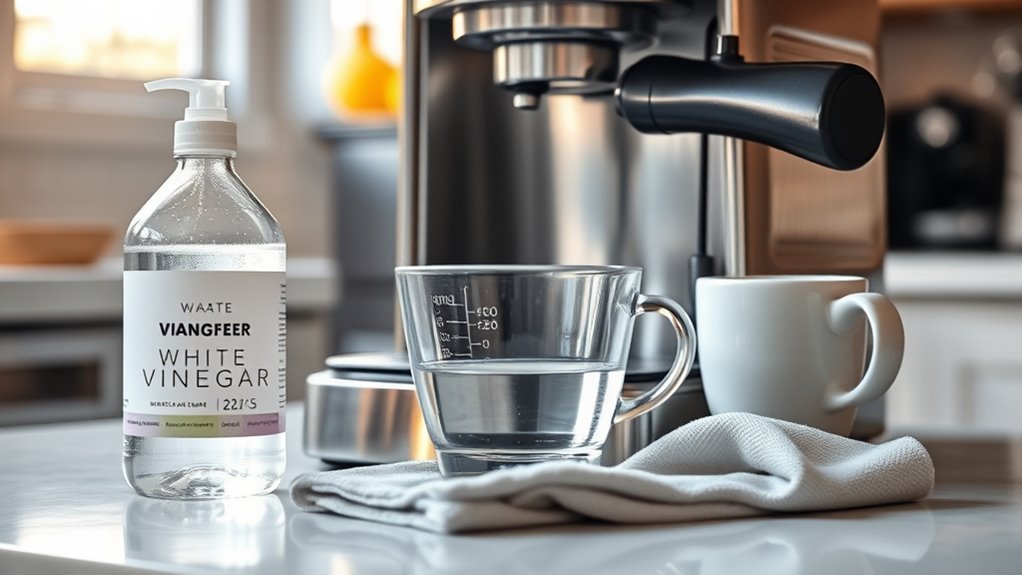
Descaling your coffee machine every few months is essential to keep it brewing at its best. Over time, mineral buildup can dull your coffee’s taste and impact coffee acidity. Follow this simple routine to enjoy fresh, vibrant brews without hassle:
Regular descaling prevents mineral buildup, ensuring your coffee stays fresh, vibrant, and perfectly balanced every time.
- Empty the water reservoir and fill it with a descaling solution or vinegar-water mix.
- Run a brewing cycle halfway, then pause to let the solution work for 30 minutes.
- Complete the cycle, then run two full cycles with clean water to rinse thoroughly.
- Wipe down the exterior and check for any leftover residue.
- Adjust your cleaning frequency based on water hardness and usage.
Stick to this routine, and your coffee maker will reward you with the freedom to savor every cup, fresh and flavorful.
Cleaning Removable Parts and Filters
Once you’ve tackled the buildup inside your coffee maker, it’s important to give attention to the removable parts and filters. Regular filter cleaning and washing removable parts like the carafe, basket, and lid will keep your coffee tasting fresh and your machine running smoothly. You want the freedom to enjoy every cup without worrying about residues or blockages.
| Removable Part | Cleaning Tip |
|---|---|
| Carafe | Wash with warm soapy water after each use |
| Filter Basket | Rinse thoroughly; soak in vinegar monthly |
| Water Reservoir | Wipe with a damp cloth; avoid submerging |
| Filter | Replace or rinse based on manufacturer’s advice |
Handling these parts carefully guarantees your coffee maker stays in top shape, giving you the freedom to brew with confidence.
Tips for Daily and Weekly Coffee Maker Care

To keep your coffee maker running smoothly, you’ll want to stick to a simple daily cleaning routine that removes leftover grounds and oils. Once a week, a deeper clean and descaling will help prevent buildup and maintain flavor. Let’s go over easy steps for both daily care and weekly maintenance.
Daily Cleaning Routine
Keeping your coffee maker clean doesn’t have to be complicated. With simple daily maintenance, you can enjoy fresh coffee flavor every morning without hassle. Here’s a quick daily cleaning routine to keep your machine in top shape:
- Empty and rinse the carafe and filter basket after each use.
- Wipe down the exterior with a damp cloth to remove spills.
- Check and clean the water reservoir weekly to prevent buildup.
- Use a damp cloth to clean the warming plate carefully.
- Leave the lid open to air dry and prevent mold.
Following these easy steps protects your coffee’s taste and keeps your machine ready to brew freedom in every cup. Stick to this routine, and your coffee maker will reward you with consistent, delicious coffee.
Weekly Deep Maintenance
Although daily cleaning keeps your coffee maker running smoothly, weekly deep maintenance is essential to tackle buildup and guarantee peak performance. By sticking to a weekly checklist and cleaning schedule, you make sure your machine stays fresh and free from residue that affects taste and longevity. Here’s a simple guide to keep you on track:
| Task | Frequency |
|---|---|
| Wash removable parts | Weekly |
| Clean water reservoir | Weekly |
| Wipe exterior | Weekly |
| Check and clean filter basket | Weekly |
| Inspect for mold or buildup | Weekly |
Following this routine gives you freedom from frequent breakdowns and keeps your coffee tasting great every morning. Make it part of your weekly rhythm and enjoy your brew without worry.
Descaling Techniques Explained
Since mineral buildup can seriously affect your coffee maker’s performance and taste, descaling is an essential step in both daily and weekly care routines. To keep your machine running smoothly, you’ve got options, like commercial descaling solutions or the classic vinegar method. Each offers a simple, effective way to dissolve deposits and free your coffee maker from stubborn scale.
Here’s how to handle descaling with ease:
- Choose a descaling solution or mix equal parts water and white vinegar.
- Fill the water reservoir with your chosen descaling liquid.
- Run a brew cycle without coffee grounds.
- Rinse thoroughly by running several cycles with clean water.
- Repeat weekly or monthly based on your water hardness and usage.
This routine keeps your coffee tasting fresh and your machine happy—freedom from buildup guaranteed!
Preventative Measures to Extend Your Coffee Maker’s Lifespan
To extend your coffee maker’s lifespan, you’ll want to adopt a few simple habits that prevent wear and tear. First, always use filtered water to reduce mineral buildup, which preserves machine longevity and maintains coffee quality. Regularly clean removable parts like the filter basket and carafe to avoid residue that can degrade your brew’s flavor. Don’t leave water sitting in the reservoir for long periods, as stagnant water can cause damage. Also, avoid using harsh chemicals—stick to gentle cleaning solutions or vinegar for descaling. Finally, unplug your machine when not in use to protect its electrical components. By embracing these preventative measures, you guarantee your coffee maker serves you well, giving you the freedom to enjoy fresh, delicious coffee every morning without interruptions.
Frequently Asked Questions
Can I Use Vinegar Instead of Commercial Descaling Solutions?
You can definitely use vinegar as a descaling alternative, and it comes with some vinegar benefits like being natural, affordable, and easy to find. If you want more freedom from commercial products, vinegar works well to break down mineral buildup. Just mix it with water and run it through your machine, then rinse thoroughly. That said, some prefer commercial solutions for their specific formulations, but vinegar’s a great, flexible option.
How Often Should I Replace My Coffee Maker’S Water Filter?
For flawless flavor, filter replacement frequency is fundamental. Depending on water filter types—charcoal, carbon, or others—you’ll generally want to replace your water filter every 2 to 3 months. This keeps contaminants at bay and brews bold, beautiful coffee. Of course, if you savor softer, smoother sips or notice slower water flow, switching sooner can set you free from stale tastes. Keep your routine relaxed but regular for peak freshness!
Is It Safe to Put Coffee Maker Parts in the Dishwasher?
You might wonder about dishwasher safety when it comes to your coffee maker parts. It really depends on the materials used—some plastic or metal components can handle the dishwasher, while others can warp or degrade. To keep your freedom from fussing with hand washing, check your coffee maker’s manual or labels for dishwasher-safe parts. That way, you can enjoy hassle-free cleaning without risking damage to your favorite brew gear.
What Are the Best Water Types for Brewing Coffee?
They say, “You are what you eat,” and the same goes for coffee—you are what you brew. When choosing water for your coffee, filtered water is your best friend because it removes impurities that can mask flavor. Pay attention to mineral content, too; a moderate amount enhances taste and extraction, giving your freedom-loving palate a balanced, vibrant cup. So, skip tap water and let filtered water release your brew’s full potential.
How Do I Fix a Coffee Maker That Won’T Brew Properly?
If your coffee maker won’t brew properly, start with some coffee maker troubleshooting. Check if the machine’s plugged in and the water reservoir’s filled. Brewing issues often come from clogged filters or mineral buildup, so make sure those aren’t blocking the flow. Resetting the machine or running a water-only cycle can help, too. If it still won’t brew right, consult the manual or contact support to get back your freedom to enjoy fresh coffee.

